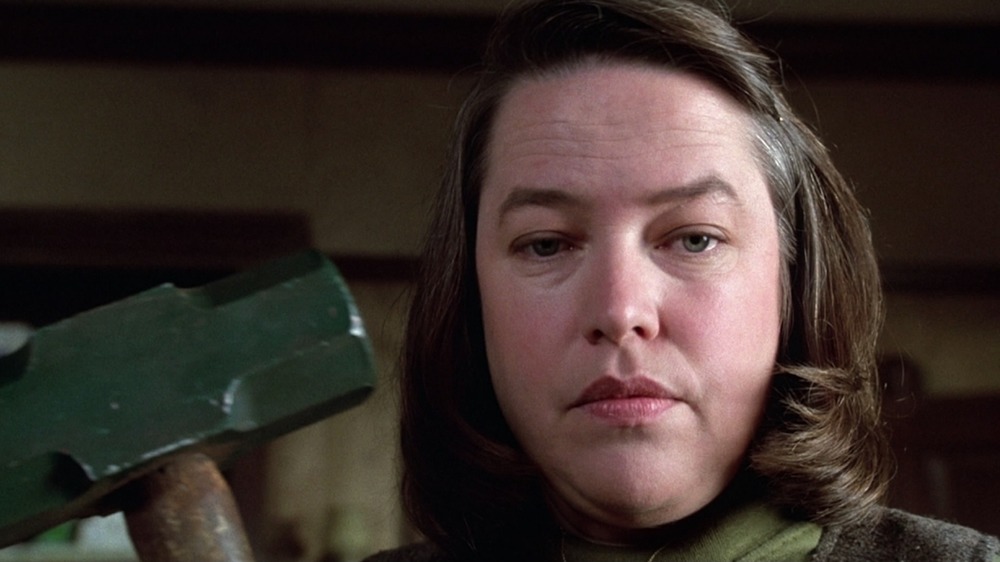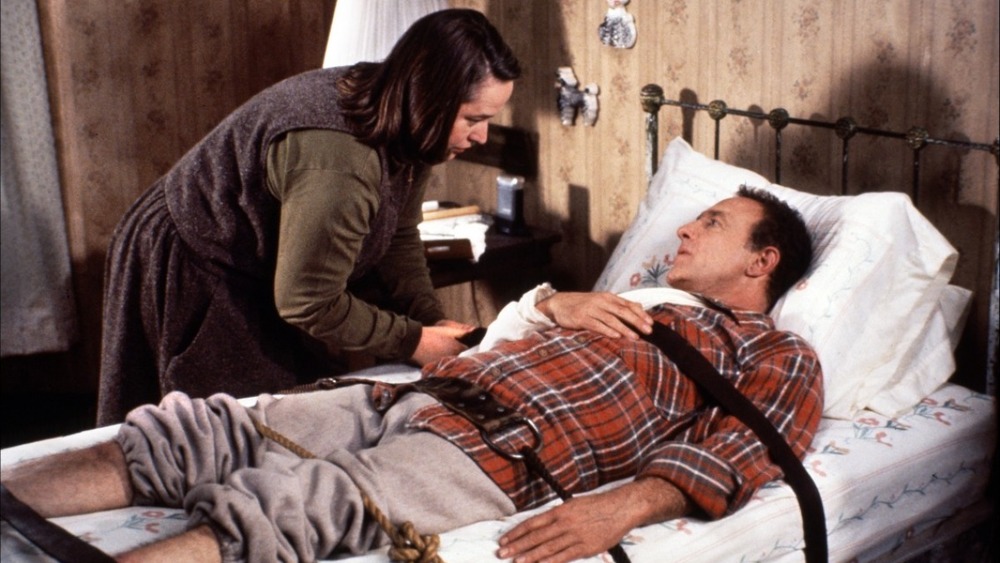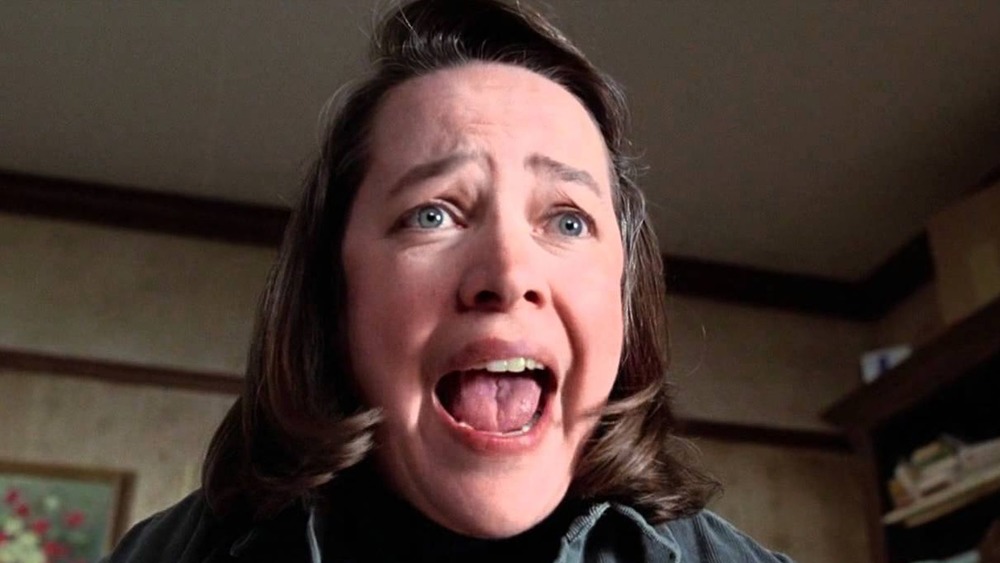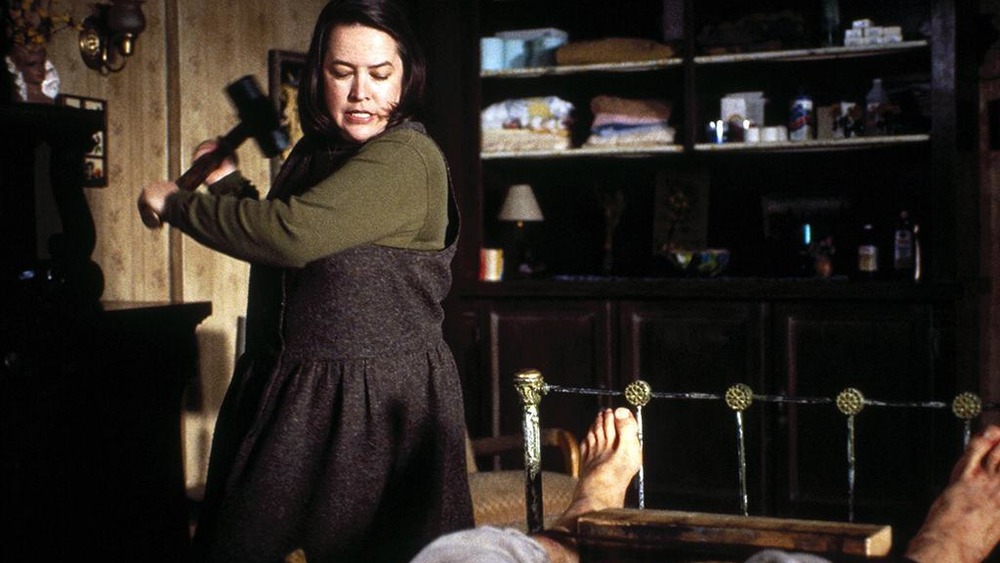The Truth About Kathy Bates' Hobbling Scene In Misery
In the vaunted, if often spotty canon of cinematic Stephen King adaptions, it's safe to say that 1990's Misery continues to hold a distinct spot in the minds and nightmares of its fans. Adapted from King's beloved novel of the same name by William Goldman, and directed by Rob Reiner (the same pairing that conjured 1987's The Princess Bride if you can believe it), Misery proved a bit of an outlier in the author's oeuvre of the macabre in that it dealt less in supernatural chills and more in the visceral horrors of humanity itself, and depicted those horrors in traumatizing fashion. Thirty-plus years have passed since Misery made its cinematic debut, and those who've witnessed the unholy horrors within are likely still trying to shake parts of the film from their memories.
Even if you count yourself among the many die-hard fans of the film, though, there's at least one scene any and every Misery lover would still prefer to unsee.
The moment in question is, after all, not just the most infamous in the adaptation, but one of the most unsettling ever committed to film. Commonly referred to as the "hobbling" scene, it finds Annie Wilkes (the great Kathy Bates) taking extreme measures to ensure her captive and favorite author Paul Sheldon (James Caan) remains in her care until he finishes rewriting his new novel to her own wants. Annie's extreme method, you ask? Placing a block of wood between Paul's legs, and taking a sledgehammer to his feet.
Yes, the moment is every bit as vicious as it sounds. And yes, it's the sort of scene one can simply never unsee. Here's a few things you may not know about Kathy Bates' hobbling scene from Misery.
The hobbling scene was much worse in Stephen King's novel
As any Stephen King reader will tell you, as bad as the hobbling scene is in Misery's film adaptation, the moment is actually a lot worse in the author's source material — as in, it almost seems like Paul Sheldon got off a little easy with that sledgehammer ankle-smashing in the big screen adaptation.
Why? Because at least he got to keep his ankle.
Indeed, in King's novel, the hobbling scene is far more brutal, and finds Annie not just shattering her captive's ankles with a sledgehammer, but lopping off Sheldon's left foot with a single, savage swing of an axe. She then cauterizes the wound with a propane torch, and proceeds to nurse her patient back to reasonable health. As you can imagine, the scene is more than a little difficult to even read, so the thought of bringing it to life on the big screen led to much debate for those involved in the adaptation.
Surprisingly, screenwriter William Goldman was firmly on the side of keeping the scene in tact. As covered by Yahoo! Entertainment, Goldman even admits in his book Which Lie Did I Tell? More Adventures in the Screen Trade that the hobbling scene as written by King was the moment he new he had to pen the Misery adaptation himself. "I could not f—ing believe it. I mean, I knew she wasn't going to tickle him with a peacock feather, but I never dreamt such behavior was possible. And I knew I had to write the movie."
The hobbling scene in Misery turned a lot of people off the project
Rob Reiner was initially just as enthusiastic about keeping the scene in the film. The problem was most of the people who were reading Goldman's screenplay were nowhere near as keen to unleash the hobbling, as written, on the cinematic masses. That includes Misery's original director George Roy Hill (Butch Cassidy and the Sundance Kid) who walked away from the project rather than be the man tasked with hobbling the minds of the masses. He left after reportedly telling Reiner, "I was up all night. And I just could not hear myself saying, 'Action!' on that scene."
As it happens, Hill wasn't the only one who couldn't get past the hobbling, as several high profile actors including Bette Midler and Warren Beatty passed on the project over the scene. Midler would later admit the pass was a mistake, telling the New York Times that, "I turned that down because I didn't want to saw off someone's foot."
As for Beatty, Goldman claims the actor believed losing his foot would somehow make Sheldon less of a hero. In the end, Reiner sided with Beatty and the anti-axing lobby, softening the grueling scene ever so slightly, and later justifying the decision on the film's DVD commentary. "We wanted Paul Sheldon at the end of this movie to emerge victorious over Annie Wilkes, and if he wound up without a foot — even if he winds up beating her and she dies — then he maybe paid too high a price for that. Most of the people who have seen this movie say it was pretty darn painful to look at, so I don't think we compromised it too much."
Misery's hobbling scene required extensive effects work
After Hill's departure, Rob Reiner decided to direct Misery himself. And when it came time to call "Action!" on the hobbling scene, he might've regretted changing it, as the smashing of ankles required a bit more special effects magic than simply lopping off a fake foot.
Effects guru Howard Berger was tasked with making the ghastly moment a reality. And per Berger's detailed account of the hobbling to Yahoo! Entertainment, the effect was every bit as complicated to produce as you'd imagine, particularly as Reiner wanted to shoot parts of the scene in extreme close-up. To make the moment work, Berger and his team first molded gelatin casts of James Caan's legs, then fitted each with wire armatures that would hold the false ankle at an angle, simulating the breakage after Bates' sledgehammer made contact with the molds.
The problem was that after several takes of the scene, the armatures were no longer working, leaving the prosthetic foot to dangle freely instead of bending awkwardly. Per that Yahoo! piece, Berger claims he fixed the issue by pulling the ankle to a freakish angle himself with fishing wire. "I went to the special effects guy, and I grabbed monofilament and sewed it through the foot. And I was right off the corner of the bed, so when Kathy hit it, I pulled the fishing line as tight as I could, and it would just keep the foot there the whole time."
However Reiner, Berger, and the rest of the Misery team brought the scene to life, it remains one of the most vivid, unshakably realistic depictions of onscreen violence from the pre-CGI era. And the horrifying end result is a big part of why Misery continues to rank among the best of Stephen King adaptations.



